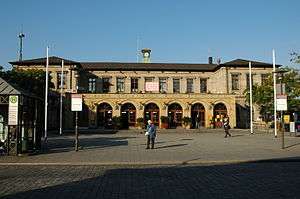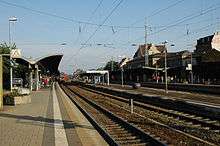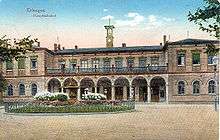Erlangen station
Erlangen station is located on the Nuremberg–Bamberg railway in the German state of Bavaria. It is the oldest railway station of the city of Erlangen and it is the only station in the city served by long-distance trains. It is classified by Deutsche Bahn as a category 3 station[2] and has four platform tracks.
| Through station | |||||||||||||||||||||||||||||||||||||||||
 Station forecourt and entrance building | |||||||||||||||||||||||||||||||||||||||||
| Location | Bahnhofsplatz 1, Erlangen, Bavaria Germany | ||||||||||||||||||||||||||||||||||||||||
| Coordinates | 49°35′46″N 11°0′7″E | ||||||||||||||||||||||||||||||||||||||||
| Owned by | Deutsche Bahn | ||||||||||||||||||||||||||||||||||||||||
| Operated by | DB Station&Service | ||||||||||||||||||||||||||||||||||||||||
| Line(s) |
| ||||||||||||||||||||||||||||||||||||||||
| Platforms | 4 | ||||||||||||||||||||||||||||||||||||||||
| Connections |
| ||||||||||||||||||||||||||||||||||||||||
| Other information | |||||||||||||||||||||||||||||||||||||||||
| Station code | 1650 | ||||||||||||||||||||||||||||||||||||||||
| DS100 code | NER [1] | ||||||||||||||||||||||||||||||||||||||||
| IBNR | 8001844 | ||||||||||||||||||||||||||||||||||||||||
| Category | 3 [2] | ||||||||||||||||||||||||||||||||||||||||
| Fare zone | VGN: 400[3] | ||||||||||||||||||||||||||||||||||||||||
| Website | |||||||||||||||||||||||||||||||||||||||||
| History | |||||||||||||||||||||||||||||||||||||||||
| Opened | 25 August 1844 | ||||||||||||||||||||||||||||||||||||||||
| Services | |||||||||||||||||||||||||||||||||||||||||
| |||||||||||||||||||||||||||||||||||||||||
| Location | |||||||||||||||||||||||||||||||||||||||||
 Erlangen Location in Bavaria  Erlangen Location in Germany  Erlangen Location in Europe | |||||||||||||||||||||||||||||||||||||||||
Location
The station is located on the western edge of the old town of Erlangen and extends on a north-south orientation from the Am Altstädter Friedhof overpass to the Güterhallenstraße overpass.
Infrastructure

The station has four through tracks, of which tracks 1 and 4 are used for long-distance and regional trains to pass and tracks 2 (not used for normal services) and 3 are used for regional trains starting and ending in Erlangen. Each platform has digital destination displays and seating protected from the weather. All platforms are connected by a pedestrian underpass with each other and to the east of the station and to a bus station on the west of the railway property. The eastern entrance is via escalators through the entrance building and is via a barrier free ramp to the Westliche Stadtmauerstraße. The western access from the bus station is at ground level.
The main platform (track 1) is 421 m long and 76 cm high and has cover provided by the entrance building. It is accessible by a ramp and stairs from street level. Tracks 2 and 3 are next to a 140 m long and 76 cm high island platform, which is partly covered and is connected to the pedestrian tunnel by stairs (on both sides of the tunnel) and a lift. This platform was fully refurbished in 2012. Track 4 is next to a 383 m long and 76 cm high side platform,[4] which is partly covered. It is connected to the pedestrian underpass from both sides via fixed stairs. Barrier-free access to platform 4 is provided by a ramp from the pedestrian underpass at the northern end of the platform and from Friedrich-List-Strasse to the southern end of the platform.
In the station building there is a part-time ticket office and a waiting room. There is also a station bookstore, catering and sanitary facilities. There are a total of 1,262 bicycle parking spaces that are partly covered on both sides of the station. On the west side there are also 2,136 park-and-ride parking spaces for cars.
Rail services
In long-distance services, the station is served by line 18 (Hamburg–Berlin–Halle–Erfurt–Erlangen–Nuremberg–Augsburg/Ingolstadt–Munich) at two-hour intervals, which is operated by ICE 1 multiple units. In regional services, the station is served by Regional-Express services on timetable route 820 (Nuremberg–Fürth–Erlangen–Forchheim–Bamberg–Lichtenfels–Sonnenberg) and route 891.2 (Nuremberg–Fürth–Erlangen–Forchheim). The RE trains are operated with Talent 2 services running at up to 160 km/h. These services are designated as line R2 by the Greater Nuremberg Transport Association (Verkehrsverbund Großraum Nürnberg, VGN). Since December 2010, Nuremberg S-Bahn line S1 has also run to Erlangen station.
| Line/ train class |
Route | Frequency | |
|---|---|---|---|
| ICE 18 | (Hamburg –) Berlin – Halle – Erfurt – Erlangen – Nuremberg – Ingolstadt / Augsburg – Munich | Every 2 hours | |
| RE | Franken-Thüringen-Express: Nuremberg – Fürth – Erlangen – Bamberg |
– Schweinfurt – Würzburg (– Frankfurt) | Every 2 hours |
| – Lichtenfels – Coburg – Sonneberg | Hourly | ||
| – Lichtenfels – Saalfeld – Jena | Every 2 hours | ||
| (Bamberg –) Forchheim – Erlangen – Fürth – Nuremberg – Lauf – Hersbruck (– Hartmannshof) | 20/40/(60) minutes | ||
East of the station is the Hauptbahnhof bus stop, formerly called Bahnhofsplatz,[5] which is served by city bus routes 281, 283–289 and 293–295 operated by Erlanger Stadtwerke (the city utility), by routes 20, 30 and 30E operated by Verkehrs-Aktiengesellschaft Nürnberg (VAG, the Nuremberg municipal public transport company), and by regional bus routes 202, 203, 205 and 253 operated by Omnibusverkehr Franken (OVF, a regional bus company, based in Nuremberg and owned by Deutsche Bahn). The bus station to the west of the station is served by regional bus routes 201, 208–210 and 254 operated by OVF.[6]
Architecture
The now listed station building[7] was designed by Eduard Rüber and built as a single-storey sandstone building. It consisted of an open central building which had waiting rooms for passengers as extensions to the north and south. Between 1868 and 1870, the first reconstruction was carried out by Friedrich Bürklein, in which the entire building was enlarged and the veranda was converted into an open loggia with Renaissance Revival elements. The loggia was enclosed in 1919 and it was replaced in the 1950s by a modern waiting room. During the last renovation in 1991, the loggia was restored to its appearance before the postwar modernisation.
History

The station was opened, along with Nuremberg–Bamberg section of the Ludwig South-North Railway, by the Bavarian State Railway on 25 August 1844, the birthday of King Ludwig I. However, regular operations on the line commenced only on 1 September 1844, on completion of all construction work, and passenger service started a month later on 1 October 1844. The Erlangen-Gräfenberg secondary railway (Sekundärbahn Erlangen–Gräfenberg, known as the Seku) was opened to the station on 17 November 1886. The trains of the secondary line usually ended at a platform south of the station building. Due to the increasing volume of traffic, the single-track Nuremberg–Bamberg line was no longer sufficient and the line was duplicated, starting from the Nuremberg end in 1891, and put into operation from Fürth in 1892. On 1 October 1894, a suburban service commenced from Nürnberg Hauptbahnhof, with one of the services ending in Erlangen. The station was also the terminus of passenger trains on the Erlangen-Bruck–Herzogenaurach railway until passenger operations ended on 28 September 1984. The station has been served by electrically-operated services since 15 May 1939. After the Second World War and the division of Germany, the main traffic flow on the Nuremberg–Bamberg line shifted to the north on the line via Würzburg and thus the station was now served by long-distance services on this route. It lost its function as a junction with the closure of the Seku on 17 February 1963. In the late 1960s, an improved local transport service with dense regular-interval services was introduced on the main lines in Nuremberg, as a precursor to a possible S-Bahn system, and Erlangen was integrated in this network. The plans were confirmed in the 1980s and it was agreed that Erlangen would be included in the second stage of the Nuremberg S-Bahn network, although it was included from the beginning in the Greater Nuremberg Transport Association, which was founded on 27 September 1987. After the fall of the Wall and the reunification, long-distance services to Berlin improved considerably.
Planning
The station's track layout and itsinfrastructure are being adapted in preparation for the opening of Nuremberg–Erfurt high-speed railway and the extension of the S-Bahn to Forchheim. The two outer tracks (1 and 4) will continue to be used by long-distance and fast regional services and the two middle tracks (2 and 3) are reserved for the S-Bahn, for which the existing platform has been raised to the level of the S-Bahn (140 m long and 76 cm high).[8] The double track connection between track 2 and 3 at the southern end of the platform is to be removed[9] and replaced by connections between all tracks to the north of the station.[10] A reversing track is to be built for S-Bahn trains terminating in Erlangen between the bridge over Martinsbühler Straße and the bridge over the Schwabach.[11]
Notes
- Eisenbahnatlas Deutschland (German railway atlas) (2009/2010 ed.). Schweers + Wall. 2009. ISBN 978-3-89494-139-0.
- "Stationspreisliste 2020" [Station price list 2020] (PDF) (in German). DB Station&Service. 4 November 2019. Retrieved 15 November 2019.
- "Tarifzonenplan: VGN-Gesamtraum" (PDF). Verkehrsverbund Großraum Nürnberg. 1 January 2019. Retrieved 20 October 2019.
- "Platform information for Erlangen station" (in German). Deutsche Bahn. Archived from the original on 3 March 2016. Retrieved 15 April 2013.
- "Änderungen in Erlangen" (Press release) (in German). Verkehrs-Aktiengesellschaft Nürnberg. Archived from the original on 12 February 2013. Retrieved 15 April 2013.
- "Liniennetz Erlangen]" (PDF) (in German). Verkehrsverbund Großraum Nürnberg. Archived from the original (PDF; 849 kB) on 14 March 2013. Retrieved 15 April 2013.
- "Erlangen station" (in German). Bavarian State Office of Historic Monuments. Archived from the original on 2016-03-04. Retrieved 15 April 2013.
- "Explanatory report on the Erlangen zoning section" (PDF; 6.3 MB) (in German). DB ProjektBau GmbH. Retrieved 15 April 2013.
- "Erlangen zoning section, annex 11" (PDF; 3.3 MB) (in German). DB ProjektBau GmbH. Retrieved 15 April 2013.
- "Erlangen zoning section, annex 12" (PDF; 3.4 MB) (in German). DB ProjektBau GmbH. Retrieved 15 April 2013.
- "Erlangen zoning section, annex 13" (PDF; 2.9 MB) (in German). DB ProjektBau GmbH. Retrieved 15 April 2013.
References
- Christoph Friederich; Bertold Freiherr von Haller; Andreas Jakob, eds. (2002). Erlanger Stadtlexikon (in German). Nuremberg: W. Tümmels Verlag. ISBN 3-921590-89-2. Retrieved 15 April 2013.
External links
| Wikimedia Commons has media related to Erlangen station. |
- "Departures board for Erlangen station" (in German). Deutsche Bahn. Retrieved 15 April 2013.
- "Track plan of Erlangen station" (PDF; 258.97 KB) (in German). Deutsche Bahn. Retrieved 15 April 2013.